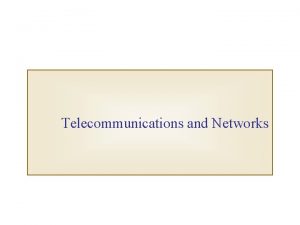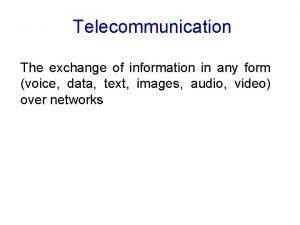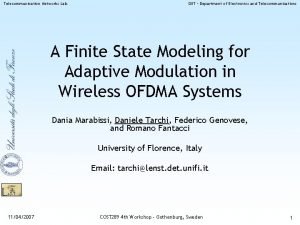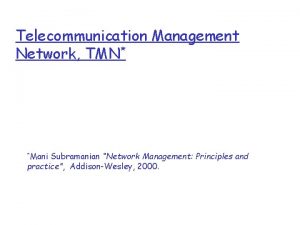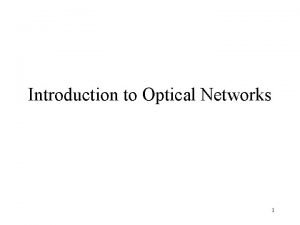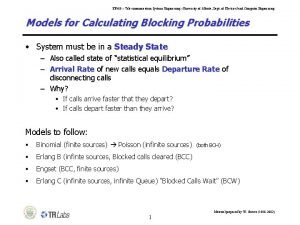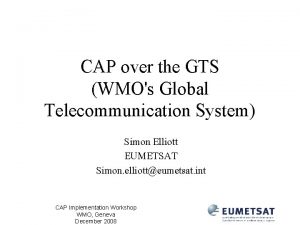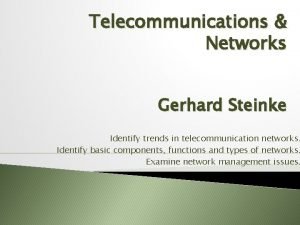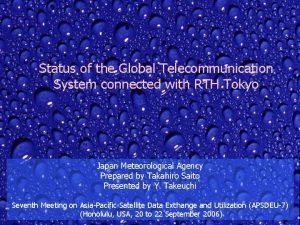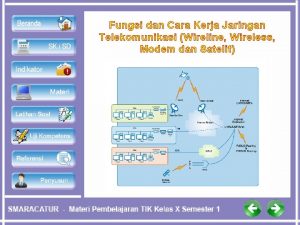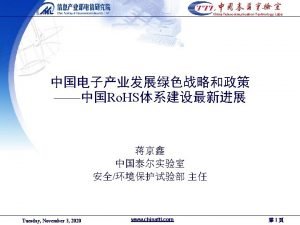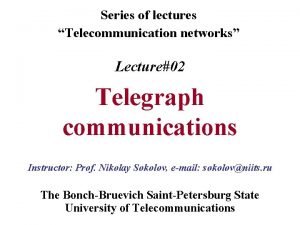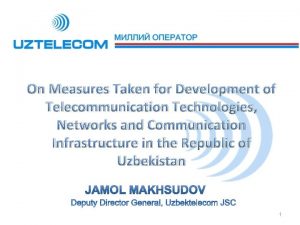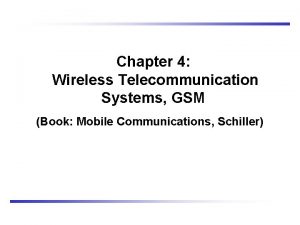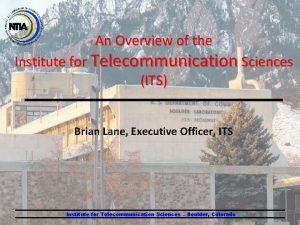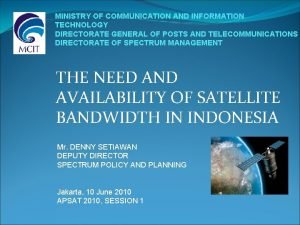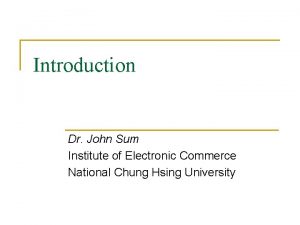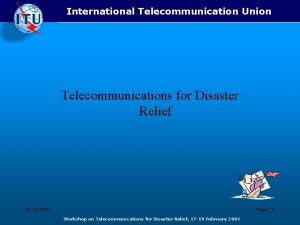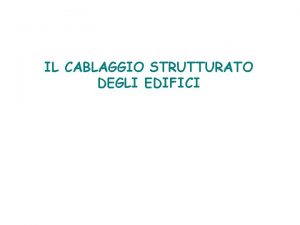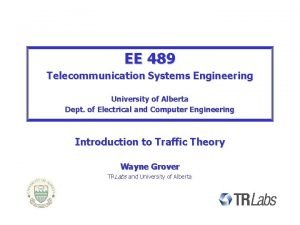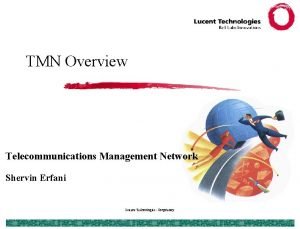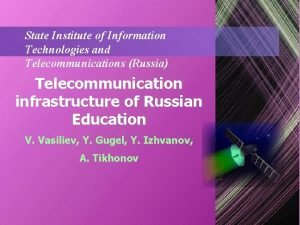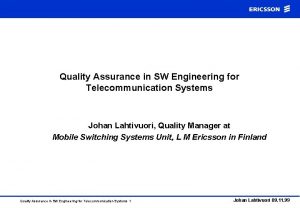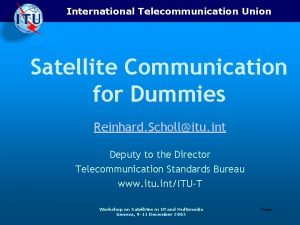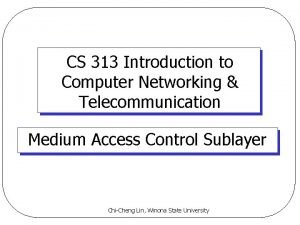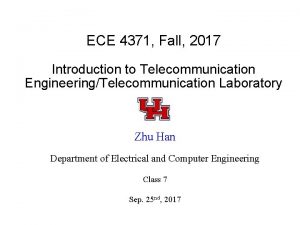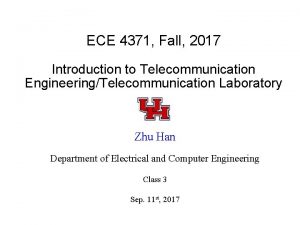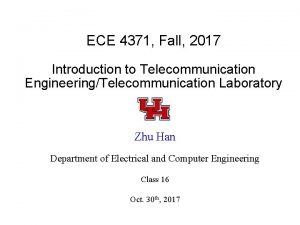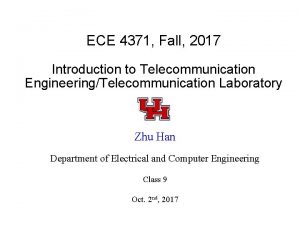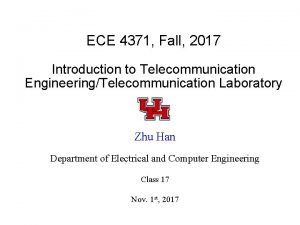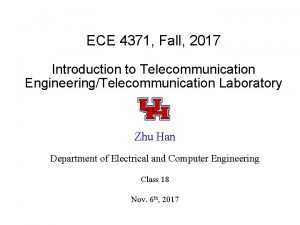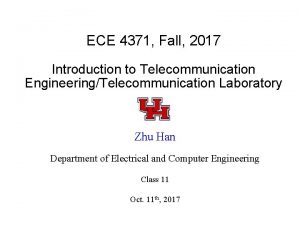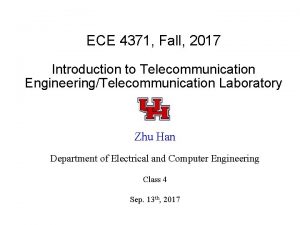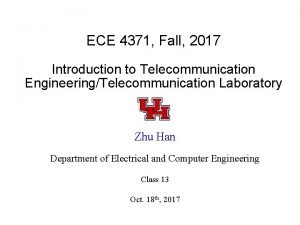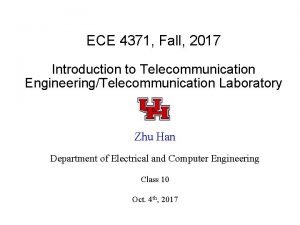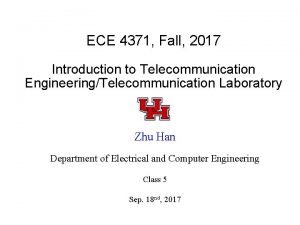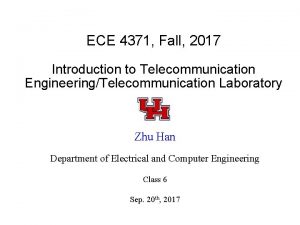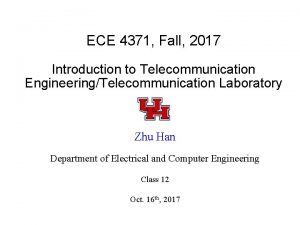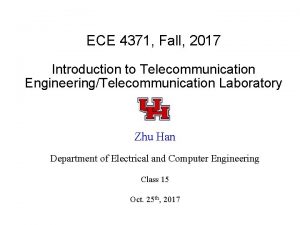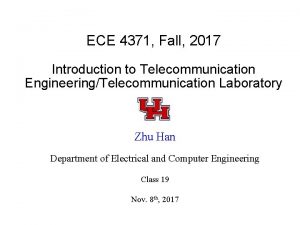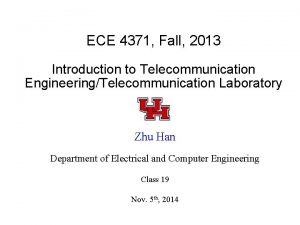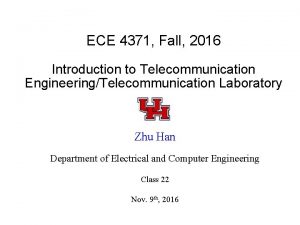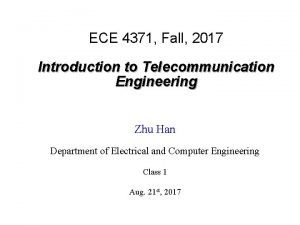ECE 4371 Fall 2017 Introduction to Telecommunication EngineeringTelecommunication




![Double Sideband l l l Modulation: m(t)cos(wct) 0. 5[M(w-wc)+M(w+wc)] Low/upper side band (LSB/USB), Double Double Sideband l l l Modulation: m(t)cos(wct) 0. 5[M(w-wc)+M(w+wc)] Low/upper side band (LSB/USB), Double](https://slidetodoc.com/presentation_image_h/db44708af1fff55416c414b3a2160c30/image-5.jpg)
































- Slides: 37

ECE 4371, Fall, 2017 Introduction to Telecommunication Engineering/Telecommunication Laboratory Zhu Han Department of Electrical and Computer Engineering Class 2 Sep. 6 th, 2017

Overview l Chapter 4. 1 -4. 3, basics of amplitude modulation l Other – GPS – Type of waves – Satellite communication basics

Baseband Carrier Communication l Baseband: - Describes signals and systems whose range of frequencies is measured from 0 to a maximum bandwidth or highest signal frequency - Voice: Telephone 0 -3. 5 KHz; CD 0 -22. 05 KHz - Video: Analog TV 4. 5 MHz, TV channel is 0 -6 MHz. Digital, depending on the size, movement, frames per second, … - Example: wire, coaxial cable, optical fiber, PCM phone l Carrier Communication: - Carrier: a waveform (usually sinusoidal) that is modulated to represent the information to be transmitted. This carrier wave is usually of much higher frequency than the modulating (baseband) signal. - Modulation: is the process of varying a carrier signal in order to use that signal to convey information. - Example on the board.

Modulation l Modulation - l A process that causes a shift in the range of frequencies of a signal. Gain advantages - Antenna size: half of the antenna size. Thousands of miles for baseband - Better usage of limited bandwidth: less side lopes - Trade bandwidth for SNR: CDMA l l - Robust to inter-symbol-interference (multipath delay) - Robust to errors and distortions Types - Analog: AM (DSB, SSB, VSB), FM, Delta modulation - Digital: ASK, FSK, PSK, QAM, … - Pulse modulation: PCM, PDM, … Fiber, phone Advanced: CDMA (3 G), OFDM (WLAN, WMAN), ….
![Double Sideband l l l Modulation mtcoswct 0 5MwwcMwwc Lowupper side band LSBUSB Double Double Sideband l l l Modulation: m(t)cos(wct) 0. 5[M(w-wc)+M(w+wc)] Low/upper side band (LSB/USB), Double](https://slidetodoc.com/presentation_image_h/db44708af1fff55416c414b3a2160c30/image-5.jpg)
Double Sideband l l l Modulation: m(t)cos(wct) 0. 5[M(w-wc)+M(w+wc)] Low/upper side band (LSB/USB), Double side band (DSB) DSB-SC: suppressed carrier, no carrier frequency Wc >= bandwidth of the signal to avoid aliasing. Demodulation: e(t)=m(t)(cos(wct))^2=0. 5(m(t)+m(t)cos(2 wct)) E(w)=0. 5 M(w)+0. 25(M(w+2 wc)+M(w-2 wc)) Low pass filter to remove the higher frequency Coherent and non-coherent detection l – Receiver can recover the frequency and phase of the transmitter by PLL. Error of timing can cause the performance error floor – Non-coherent receiver has 3 d. B worst performance than coherent. – Cheaper for Non-coherent receiver, Nextel.

AM-DSB-SC l Example 4. 1 0 0 Lower sideband (LSB) 0 Upper sideband (USB)

Categories of Modulators l Multiplier Modulators – Multiply m(t) by cos(wct) – Hard for linearity for high energy. Expensive. e. g. sound system l Nonlinear Modulators – Example l Switching Modulators – FFT transform to series of frequencies – Series-bridge diode modulator, shunt-bridge diode modulator – Ring Modulators

Frequency Conversion l Move the signals to other frequency l Multiplying two sinusoids results in two frequencies which are the sum and difference of the frequencies of the sinusoids multiplied. BPF@ I EXAMPLE : Let m(t) be as shown. m(t) l To change the carrier frequency c of a modulated signal to an intermediate frequency I we use an oscillator to generate a sinusoid of frequency MIX such that SPECTRA 0 0 0 l Example 4. 2, 4. 3 e 1(t)

Amplitude Modulation l Why DSB-SC not working: do not know the carrier frequency in receiver. l The last impulse functions indicate that the carrier is not suppressed in this case. For some M() shown, the modulated signal spectrum is as shown. 0 0 l With this type of AM the demodulation can be performed with/without a local oscillator synchronized with the transmitter.

AM Example • m(t) has a minimum value of about -0. 4. Adding a dc offset of A=1 results in A+m(t) being always positive. Therefore the positive envelope of is just A+m(t). An envelope detector can be used to retrieve this. A=1 m(t) 0. 7 0. -0. 4 A+m(t) 1.

AM Example (cont. ) l The choice of dc offset should be such that A+m(t) should always be positive. Otherwise envelope detector cannot be used, but coherent still ok l For example, the minimum value of m(t) = -0. 4. Therefore A > |min(m(t))| for successful envelope detection. What if A< |m(t) |. l In the previous example let A=0. 3. A+m(t) 0. 7 0. -0. 4 0

Modulation Index • l Let mp be the absolute negative peak of m(t). EXAMPLE : Single-tone modulation. Let m(t)=2 sin(20 t) m(t)

Sideband Carrier Power Example 4. 4, 4. 5

AM Generator m(t) + - AM output c cos( ct) + -

Coherent detector for demodulating DSB-SC modulated wave.

AM Nocoherent Decoder l Rectifier Detector: synchronous l Envelope Detector: asynchronous + AM signal R C vc(t) -

RC Selection E(t)=A(1+ cos(wct))

QAM l AM signal BANDWIDTH : AM signal bandwidth is twice the bandwidth of the modulating signal. A 5 k. Hz signal requires 10 k. Hz bandwidth for AM transmission. If the carrier frequency is 1000 k. Hz, the AM signal spectrum is in the frequency range of 995 k. Hz to 1005 k. Hz. l QUADRARTURE AMPLITUDE MODULATION is a scheme that allows two signals to be transmitted over the same frequency range. l Coherent in frequency and phase. Expensive l TV for analog l Most modems

Single Sideband (SSB) • Purpose : to reduce the bandwidth requirement of AM by one-half. This is achieved by transmitting only the upper sideband or the lower sidebband of the DSB AM signal.

SSB Frequency baseband 0 DSB 0 SSB (Upper sideband) SSB 0

SSB Generator • Selective Filtering using filters with sharp cutoff characteristics. Sharp cutoff filters are difficult to design. The audio signal spectrum has no dc component, therefore , the spectrum of the modulated audio signal has a null around the carrier frequency. This means a less than perfect filter can do a reasonably good job of filtering the DSB to produce SSB signals. • Baseband signal must be bandpass • Filter design challenges • No low frequency components 0

SSB Generator l Phase shift method using Hilbert transformer l Non-causal filter, approximations x + m(t) ~ Hilbert Transformer + X

SSB Demodulation Synchronous, SSB-SC demodulation SSB+C, envelop detection

SSB vs. AM l Since the carrier is not transmitted, there is a reduction by 67% of the transmitted power (-4. 7 d. Bm). --In AM @100% modulation: 2/3 of the power is comprised of the carrier; with the remaining (1/3) power in both sidebands. l Because in SSB, only one sideband is transmitted, there is a further reduction by 50% in transmitted power l Finally, because only one sideband is received, the receiver's needed bandwidth is reduced by one half--thus effectively reducing the required power by the transmitter another 50% l (-4. 7 d. Bm (+) -3 d. Bm = -10. 7 d. Bm). l Relative expensive receiver

Vestigial Sideband (VSB) • VSB is a compromise between DSB and SSB. To produce SSB signal from DSB signal ideal filters should be used to split the spectrum in the middle so that the bandwidth of bandpass signal is reduced by one half. In VSB system one sideband a vestige of other sideband are transmitted together. The resulting signal has a bandwidth > the bandwidth of the modulating (baseband) signal but < the DSB signal bandwidth. DSB 0 SSB (Upper sideband) 0 VSB Spectrum

Filtering scheme for the generation of VSB modulated wave.

VSB Transceiver m(t) e(t) H i ( ) Transmitter LPF Ho( ) Receiver

Other Facts about VSB l Envelope detection of VSB+C l Analog TV: DSB, SSB and VSB – DSB bandwidth too high – SSB: baseband has low frequency component, receiver cost – Relax the filter and baseband requirement with modest increase in bandwidth l

(a) Idealized magnitude spectrum of a transmitted TV signal. (b) Magnitude response of VSB shaping filter in the receiver.

Comparison

GPS Orbits

GPS Position l By knowing how far one is from three satellites one can ideally find their 3 D coordinates l To correct for clock errors one needs to receive four satellites l Differential GPS: local FM

Type of waves

Radio Frequency Bands Classification Band Initials Frequency Range Extremely low ELF < 300 Hz Infra low ILF 300 Hz - 3 k. Hz Very low VLF 3 k. Hz - 30 k. Hz Low LF 30 k. Hz - 300 k. Hz Medium MF 300 k. Hz - 3 MHz Ground/Sky wave High HF 3 MHz - 30 MHz Sky wave Very high VHF 30 MHz - 300 MHz Ultra high UHF 300 MHz - 3 GHz Super high SHF 3 GHz - 30 GHz Extremely high EHF 30 GHz - 300 GHz Tremendously high THF 300 GHz - 3000 GHz Characteristics Ground wave Space wave

Satellite Communications Large communication area. Any two places within the coverage of radio transmission by satellite can communicate with each other. l Seldom effected by land disaster ( high reliability) l Circuit can be started upon establishing earth station (prompt circuit starting) l Can be received at many places simultaneously, and realize broadcast, multi-access communication economically( feature of multi-access) l Very flexible circuit installment , can disperse over-centralized traffic at any time. l One channel can be used in different directions or areas (multi-access connecting). l

Satellite Orbit Geostationary (GEO): 35, 786 km Beidou (MEO): 27, 878 km Hubble Space Telescope (LEO): 347 mile International Space Station (LEO): 249 mile

Rain Attenuation
 Networks and telecommunications presentation
Networks and telecommunications presentation 2017 dvhimss annual fall conference
2017 dvhimss annual fall conference Risk management in telecommunication projects
Risk management in telecommunication projects Objectives of telecommunication
Objectives of telecommunication Telecommunication information
Telecommunication information It means communication at a distance
It means communication at a distance Kyushu telecommunication network co.,inc.
Kyushu telecommunication network co.,inc. Telecommunication
Telecommunication Tmn functional architecture
Tmn functional architecture The swift society
The swift society In a telecommunications network architecture, a protocol is
In a telecommunications network architecture, a protocol is Telecommunication
Telecommunication Global telecommunication system
Global telecommunication system Telecommunication trends
Telecommunication trends Global telecommunication system
Global telecommunication system Itu world telecommunication indicators database
Itu world telecommunication indicators database Cara kerja jaringan kabel
Cara kerja jaringan kabel China telecommunication technology labs
China telecommunication technology labs Telecommunication
Telecommunication Telecommunication sealing technology
Telecommunication sealing technology Bsc and msc in telecom
Bsc and msc in telecom Institute for telecommunication sciences
Institute for telecommunication sciences World telecommunication standardization assembly
World telecommunication standardization assembly Ministry of telecommunication
Ministry of telecommunication Types of telecommunication
Types of telecommunication Telecommunication
Telecommunication Cablaggio verticale edifici
Cablaggio verticale edifici Telecommunication
Telecommunication Shervin erfani
Shervin erfani Umos msu ru
Umos msu ru Telecommunication system architecture with diagram
Telecommunication system architecture with diagram Quality control in telecommunication
Quality control in telecommunication Telecommunication sealing technology
Telecommunication sealing technology Telecommunications for dummies
Telecommunications for dummies Telecommunication medium
Telecommunication medium China telecommunication technology labs
China telecommunication technology labs Network management principles
Network management principles Telecommunication system architecture with diagram
Telecommunication system architecture with diagram



